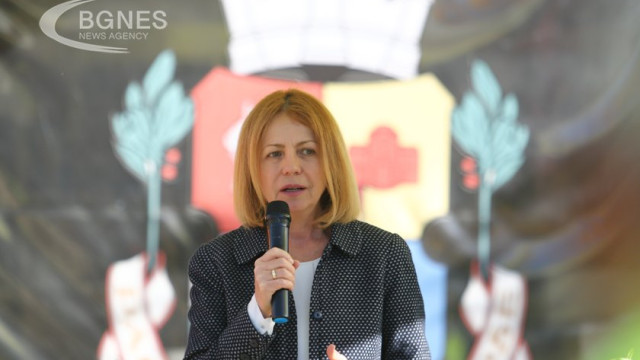Yordanka Fandakova, the mayor of Sofia, is stepping down after 15 years in the position. This comes after four successful terms in office for Fandakova, making her the city's longest-serving mayor.
The accomplishments of the government led by Fandakova (a member of the GERB party) are noteworthy.
In the time from 2009 till present, the Municipality of Sofia under the leadership of Mayor Yordanka Fandakova has completed 39.7 km. from the ring road of the capital. That's over 14 km. from the Southern arc of the ring road from Bulgaria Blvd. to the Trakia highway, 16.5 km from the northern high-speed tangent and 8.5 km - the western arc of the ring road.
The metropolitan metro, which carries approximately 380,000 people each and every day, is 52 km long in total. This prevents 80,000 tonnes of pollution every year alone. There are currently 70 brand-new metro cars, with 16 more on the way.
There are mostly new buses in the capital. While not a single bus had air conditioning in 2009, today 90% do and all of them are under constant camera monitoring.
Six essential two-level crossroads for the city's traffic were constructed, and four iconic squares were given a facelift: the "Bulgaria" square in front of the National Palace of Culture, the "Slaveykov" square, the "Garibaldi" square, and the "St. Septuagints" square.
Major work was done on 29.3 kilometres of railroad, 4.3 km of trolleybus routes, over 30 kilometres of new streets, and over 800 metres of new pathways. The subway system also features underground parking garages.
At Mayor Fandakova's urging, the Ordinance regarding annual technical inspections of cars was amended, resulting in the issuance of a "eco-sticker" to each vehicle based on its level of pollution, with restrictions placed on the most polluting vehicles beginning on December 1, 2023.
There were 33,226 new tree plantings in the nation's capital in 2015.
For the first time in many years, Sofia got three new parks: "Vazrazhdane" / over 100 decares of area, together with sports fields and facilities, children's playgrounds, a dry fountain, an amphitheater with an event area, a circus area and an automated toilet. The park is the first municipal water park in Sofia with 5 outdoor and one indoor pools with mineral water; "Batalova Vodenitsa" Park - the first linear park along "Macedonia" Blvd. between "Macedonia" Square and "Russian Monument" Square with over 182 new trees, and the first green tram route; as well as "Vertopo" park - on an area of 8 decares with an alley network, lighting, two children's and one fitness playground, park furniture and an elevator for an accessible environment.
Again under the leadership of Fandakova, the Metropolitan Municipality renovated the Metropolitan Zoo; built the largest and most modern installation for the processing of household waste in the Balkans; replaced and built 498 km of water pipes and 264 km of sewage network.
In 15 years, 144 new kindergarten buildings and 24 schools were built. This is the largest building program of educational infrastructure to ensure the places for the children in the kindergarten groups with constant growth. 94 new gymnasiums for kindergartens were also built, and 16 existing gymnasiums were reconstructed. 15 new swimming pools for kindergartens were also built.
Due to the efforts of the municipal leadership in support of mass sports, Sofia won the title of European capital of sports. In recent years, 133 outdoor gyms have been built, 128 tennis tables and 101 sports fields have been installed in the city's neighborhoods.
And the culture of the city developed enormously during these years: 4 new museums were opened - the History Museum of Sofia in the southern wing of the Central Mineral Bath, the underground museum under the basilica "St. Sofia", Triangular Tower and Archaeological Exposition Ancient Serdika. The southern wing of the Central Mineral Bath was restored and turned into the Museum of Sofia - so for the first time after 70 years without a home, the Museum of Sofia has its own building for its rich exposition. An underground museum was opened under the basilica "St. Sofia", which includes a complex of tombs and finds from 4 earlier temples. The museum covers an area of 1,400 square meters. The earliest mosaics from the church of "St. Sofia". The tomb of Honorius, which is part of the necropolis of the Hagia Sophia, was restored and exhibited.
The Triangular Tower of the fortress wall of Serdika was restored and turned into an exhibition space for archeology and contemporary art. Research and restoration of the Western Gate of Serdika began, which also became the first archaeological park. Excavations have also begun at Sveta Nedelya Square, as well as a second archaeological park near the discovered Late Antique mausoleum next to the South Park.
Five galleries, seven outdoor stages, and five satellite locations of the Metropolitan Library were opened, making "Toplocentrala" the first regional centre for modern arts.
After constructing three shelters with a combined capacity of 1,724 spaces (one each in the village of Gorni Bogrov, the "Seslavtsi" district, and the "Slatina" district), the municipality eliminated the stray dog problem entirely. In addition, the animals there receive exceptional care. The municipality also launched an animal adoption programme.
Given the current importance of fiscal matters, we might also ask: how did Mayor Fandakova of Sofia handle the city's finances? There has been no increase in capital-area resident taxes since 2006, when they totaled 629.5 million BGN, despite the fact that the capital's budget have quadrupled by 2023, to 2.551 billion BGN.
Probably only under another great mayor, Ivan Ivanov, who governed the capital from 1934 to 1944, Sofia saw a similar period of remarkable growth. /BGNES







